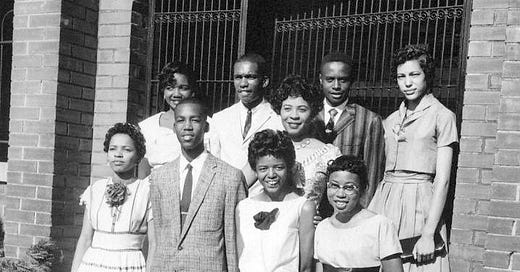Today In Black History: The Little Rock Central High Nine
Courageous Black students just trying to get an education.
Issue #729 Today In Black History, Thursday, September 19, 2024
Did you know that you can listen to each “We Are Speaking” post on the Substack App? Download the app!
Please share and subscribe to help us grow our publication.
If you like us, REALLY like us, please click the “Like” button at the end of this post!
We appreciate your support!
In 1954, the U.S. Supreme Court handed down its landmark decision in Brown v. Board of Education, declaring state laws establishing separate public schools for Black and white students unconstitutional. Despite this ruling, many schools across the South remained segregated, practicing de facto segregation under various pretenses.
Until the court’s decision, many states across the nation had mandatory Jim Crow laws, requiring African American and white children to attend separate schools. Resistance to the Brown ruling was so widespread that the court issued a second decision in 1955, known as Brown II, ordering school districts to integrate “with all deliberate speed.”
On September 4, 1957, in Little Rock, Arkansas, nine students chosen by the NAACP based on their excellent grades and attendance—Ernest Green, Elizabeth Eckford, Jefferson Thomas, Terrence Roberts, Carlotta Walls LaNier, Minnijean Brown, Gloria Ray Karlmark, Thelma Mothershed, and Melba Pattillo Beals—attempted to enter the all-white Little Rock Central High School. They were met with an angry mob and the Arkansas National Guard, acting on orders from Governor Orval Faubus to prevent their entry.
Daisy Bates and others from the Arkansas NAACP carefully vetted the students and determined they all possessed the strength and determination to face the resistance they would encounter. In the weeks before the start of the new school year, the students participated in intensive counseling sessions, which guided them on what to expect once classes began and how to respond to anticipated hostile situations.
Two pro-segregation groups formed to oppose the attendance plan: The Capital Citizens Council and the Mother’s League of Central High School.
President Dwight D. Eisenhower responded by federalizing the Arkansas National Guard and sending the 101st Airborne Division to escort the students into the school. On September 25, 1957, under the protection of federal troops, the nine students finally entered Central High School, marking a pivotal step in the enforcement of desegregation. The 101st Airborne and the National Guard remained at Central High School for the remainder of the school year.
The students experienced routine harassment and even violence throughout the rest of the year.
Melba Patillo, for instance, was kicked, beaten, and had acid thrown in her face. At one point, white students burned an African American effigy in a vacant lot across from the school. Gloria Ray was pushed down a flight of stairs, and the Little Rock Nine were barred from participating in extracurricular activities.
Minnijean Brown was expelled from Central High School in February 1958 for retaliating against the attacks. The harassment went beyond the students: Gloria Ray’s mother was fired from her job with the State of Arkansas when she refused to remove her daughter from the school.
On May 27, 1958, Ernest Green became the first African American to graduate from Little Rock Central High. Twenty-nine-year-old Rev. Dr. Martin Luther King, Jr. attended the graduation of Central High’s only Black senior student.
In September 1958, one year after Central High was integrated, Governor Faubus closed all of Little Rock’s high schools for the entire year, pending a public vote, to prevent African American attendance. Little Rock citizens voted 19,470 to 7,561 against integration, and the schools remained closed.
Other than Green, the rest of the Little Rock Nine completed their high school careers via correspondence or at other high schools nationwide. Eckford joined the Army and later earned her General Education Equivalency diploma. Little Rock’s high schools reopened in August 1959.
Despite their successful entry, the Little Rock Nine faced continuous harassment and intimidation. From verbal abuse to physical assaults, their daily existence within the school walls was fraught with danger and hostility. Yet, these young individuals remained resolute, embodying a spirit of determination and advocating for equal educational opportunities.
The group has been widely recognized for its significant role in the civil rights movement. In 1999, President Clinton awarded each Little Rock Central High Nine group member the Congressional Gold Medal. The nine also received personal invitations to attend President Barack Obama's inauguration in 2009.
Today In Black History
In 1865, Atlanta University was founded.
In 1881, Booker T. Washington opened the HBCU Tuskegee Institute.
In 1893, Black inventor E. R. Robinson patented the Electric Railway trolley.
In 1932, J. Herman Banning and his mechanic, Thomas Allen, became the first Blacks to successfully fly across the United States.
In 1956, the first international conference of Black Writers and Artists met at the Sorbonne in Paris.
In 1963, the last Divine Nine fraternity, Iota Phi Theta, was founded at Morgan State University.
In 1969, UCLA fired Professor Angela Davis for being a communist. The termination was overturned in court, but she was later fired for using inflammatory language.
In 1983, St. Kitts & Nevis declared independence from the United Kingdom.
In 1989, “The Learning Tree,” a film written and directed by Gordon Parks, the first Black person to direct a major motion picture, was registered in the National Film Registry of the Library of Congress.
Our paid subscribers are encouraged to discuss this post in our W.A.S. Chat Community.
Join Pamela Hilliard Owens’s subscriber chat
Available in the Substack app and on the web
You are also welcome to view “We Are Speaking” in Substack Notes. You can also read other Substack publications without subscribing to them when you join Notes.






